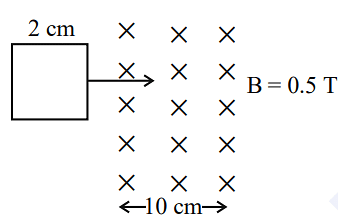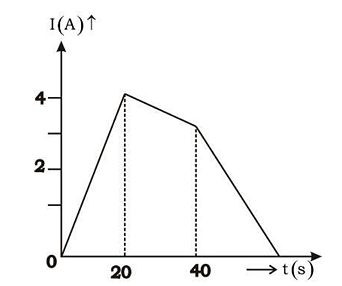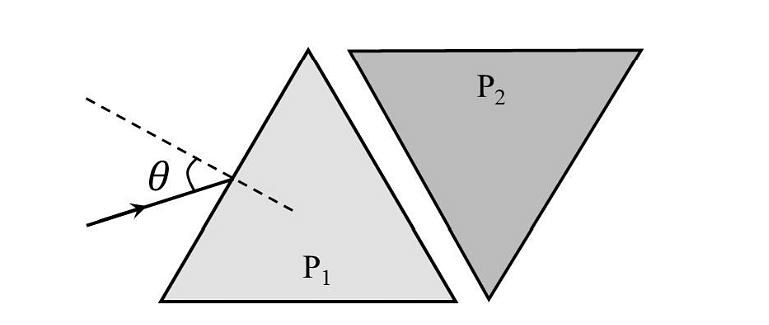Question:
A conducting loop in the shape of a right angled isosceles triangle of height $10\, cm$ is kept such that the $90^{\circ}$ vertex is very close to an infinity long conducting wire (see the figure). The wire is electrically insulated from the loop. The hypotenuse of the triangle is parallel to the wire. The current in the triangular loop is in counterclockwise direction and increased at a constant rate of $10 \,As ^{-1}$. Which of the following statement (s) is (are) true?
A conducting loop in the shape of a right angled isosceles triangle of height $10\, cm$ is kept such that the $90^{\circ}$ vertex is very close to an infinity long conducting wire (see the figure). The wire is electrically insulated from the loop. The hypotenuse of the triangle is parallel to the wire. The current in the triangular loop is in counterclockwise direction and increased at a constant rate of $10 \,As ^{-1}$. Which of the following statement (s) is (are) true?
Updated On: Jan 18, 2023
- There is a repulsive force between the wire and the loop,
- If the loop is rotated at a constant angular speed about the wire, an additional emf of $\left(\frac{\mu_{0}}{\pi}\right)$ volt is induced in the wire
- The magnitude of induced emf in the wire is $\left(\frac{\mu_{0}}{\pi}\right)$ volt
- The induced current in the wire is in opposite direction to the current along the hypotenuse
Hide Solution
Verified By Collegedunia
The Correct Option is C
Solution and Explanation
Here $\frac{ di }{ dt }=10 A / S$
for mutual inductance
$ d \phi=\frac{\mu_{0}}{2 \pi} \frac{ i }{ r }(2 r dr ) $
$\phi=\frac{\mu_{0}}{\pi} i \int\limits_{0}^{4} dr$
$\phi=\left(\frac{\mu_{0}}{\pi} d \right) i = Mi $
$ M =\frac{\mu_{0}}{\pi} d =0.1 \frac{\mu_{0}}{\pi}$
When current through loop increases then magnetic flux
$\phi= Mi $
$\varepsilon=\frac{d \phi}{ dt } $
$\varepsilon= M \frac{ di }{ dt }=\frac{\mu_{0}}{\pi} \times 10 \times 0.1$
$\varepsilon=\frac{\mu_{0}}{\pi}$
Force between loop and conductor is repulsive.
for mutual inductance
$ d \phi=\frac{\mu_{0}}{2 \pi} \frac{ i }{ r }(2 r dr ) $
$\phi=\frac{\mu_{0}}{\pi} i \int\limits_{0}^{4} dr$
$\phi=\left(\frac{\mu_{0}}{\pi} d \right) i = Mi $
$ M =\frac{\mu_{0}}{\pi} d =0.1 \frac{\mu_{0}}{\pi}$
When current through loop increases then magnetic flux
$\phi= Mi $
$\varepsilon=\frac{d \phi}{ dt } $
$\varepsilon= M \frac{ di }{ dt }=\frac{\mu_{0}}{\pi} \times 10 \times 0.1$
$\varepsilon=\frac{\mu_{0}}{\pi}$
Force between loop and conductor is repulsive.
Was this answer helpful?
0
0
Top Questions on Faradays laws of induction
- A metallic rod of length 1 m held along east-west direction is allowed to fall down freely. Given horizontal component of earth’s magnetic field BH = 3 × 10-5 T. The emf induced in the rod at an instant t = 2s after it is released is ( Take g = 10 ms-2 )
- KCET - 2023
- Physics
- Faradays laws of induction
- A square loop of side 2 cm enters a magnetic field with a constant speed of 2 cm s-1 as shown. The front edge enters the field at t = 0s. Which of the following graph correctly depicts the induced emf in the loop?
( Take clockwise direction positive )
- KCET - 2023
- Physics
- Faradays laws of induction
- The current following through an inductance coil of self inductance 6 mH at different time instants is as shown. The emf induced between t = 20s and t = 40s is nearly

- KCET - 2021
- Physics
- Faradays laws of induction
- A wheel with $20$ metallic spokes each $1\, m$ long is rotated with a speed of $120\, rpm$ in a plane perpendicular to a magnetic field of $0.4\, G$. The induced emf between the axle and rim of the wheel will be, $(1 G = 10^{-4}\, T)$
- NEET (UG) - 2020
- Physics
- Faradays laws of induction
- Which is not a application of the Faraday's law?
- TS POLYCET - 2020
- Physics
- Faradays laws of induction
View More Questions
Questions Asked in JEE Advanced exam
- Let \(S=\left\{\begin{pmatrix} 0 & 1 & c \\ 1 & a & d\\ 1 & b & e \end{pmatrix}:a,b,c,d,e\in\left\{0,1\right\}\ \text{and} |A|\in \left\{-1,1\right\}\right\}\), where |A| denotes the determinant of A. Then the number of elements in S is _______.
- JEE Advanced - 2024
- Matrices
- A block of mass \(5 kg\) moves along the \(x-\)direction subject to the force \(F = (−20x + 10) N,\) with the value of \(x \) in metre. At time \(t = 0 s,\) it is at rest at position \(x = 1 m\). The position and momentum of the block at \(t = (\pi/4)\) s are
- JEE Advanced - 2024
- Work-energy theorem
- Two equilateral-triangular prisms \(P_1 \)and \(P_2\) are kept with their sides parallel to each other, in vacuum, as shown in the figure. A light ray enters prism \(P_1\) at an angle of incidence 𝜃 such that the outgoing ray undergoes minimum deviation in prism \(P_2\). If the respective refractive indices of \(P_1\) and\( P_2\) are \(√ 3 /2\) and \(√3\), then \(\theta = sin{−1}[\sqrt \frac{ 3}{ 2} sin ( \frac{\pi}{B} )],\) where the value of \(\beta\) is ______.

- JEE Advanced - 2024
- Ray optics and optical instruments
- Let \(\overrightarrow{OP}=\frac{\alpha-1}{\alpha}\hat{i}+\hat{j}+\hat{k},\overrightarrow{OQ}=\hat{i}+\frac{\beta-1}{\beta}\hat{j}+\hat{k}\) and \(\overrightarrow{OR}=\hat{i}+\hat{j}+\frac{1}{2}\hat{k}\) be three vector where α, β ∈ R - {0} and 0 denotes the origin. If \((\overrightarrow{OP}\times\overrightarrow{OQ}).\overrightarrow{OR}=0\) and the point (α, β, 2) lies on the plane 3x + 3y - z + l = 0, then the value of l is _______.
- JEE Advanced - 2024
- Vector Algebra
- Let \(\vec{p}=2\hat{i}+\hat{j}+3\hat{k}\) and \(\vec{q}=\hat{i}-\hat{j}+\hat{k}\). If for some real numbers α, β and γ we have
\(15\hat{i}+10\hat{j}+6\hat{k}=α(2\vec{p}+\vec{q})+β(\vec{p}-2\vec{q})+γ(\vec{p}\times\vec{q})\),
then the value of γ is ________.- JEE Advanced - 2024
- Vector Algebra
View More Questions
Concepts Used:
Faradays Laws of Induction
There are two laws, given by Faraday which explain the phenomena of electromagnetic induction:
Faraday's First Law:
Whenever a conductor is placed in a varying magnetic field, an emf is induced. If the conductor circuit is closed, a current is induced, known as the induced current.
Faraday's Second Law:
The Emf induced inside a coil is equal to the rate of change of associated magnetic flux.
This law can be mathematically written as:
∈\(-N {\triangle \phi \over \triangle t}\)




